Your pricing page looks beautiful. But ChatGPT sees... nothing.
The problem? AI systems don't see your design. They don't see your interactive pricing slider. They don't see half the content you spent weeks perfecting.
This isn't a bug. It's how AI search works. And it's costing you citations.
- AI crawlers see only static HTML - no CSS, no JavaScript, no interactive elements
- Most SaaS sites have critical content invisible to AI (pricing sliders, feature tabs, dynamic loaders)
- Use AI Page Inspector to see exactly what ChatGPT, Perplexity, and Claude read from your pages
- Fix gaps with LLMOnly component - add AI-visible content without changing user experience
- AI citations depend on readable content - invisible information never gets cited
Real example: When someone asks ChatGPT "what's the best email tool for startups", Loops.so doesn't show up. Their competitor Encharge does. Why? Encharge's content is AI-readable. Loops.so's pricing slider isn't.
By the end of this post, you'll learn:
- Why AI Sees Different Content Than Humans
- The Most Common Content Gaps
- The Encharge vs Loops.so Case Study
- How to Find Your Content Gaps
- Before/After: Fixing AI-Invisible Content
Why AI Sees Different Content Than Humans
When you visit a website, you see the finished product. Beautiful design. Smooth animations. Interactive elements.
AI sees plain text.
Here's what happens when ChatGPT, Perplexity, or Claude crawls your site:
- No CSS rendering - All your styling disappears
- No JavaScript execution - Dynamic content doesn't load
- No interactive elements - Sliders, calculators, carousels vanish
- Only static HTML - What's in the initial page load
Think of it like viewing your site with images turned off. Except worse.
Most modern websites rely heavily on JavaScript for core content. Pricing tables that adjust based on user input. Feature comparisons that expand on click. Product details that load dynamically.
AI can't see any of it.
The Most Common Content Gaps
We analyzed 50+ SaaS landing pages with our AI Page Inspector. 47 of them had critical content invisible to AI.
Pricing in Interactive Sliders
The biggest issue we found. Companies hide their pricing behind JavaScript widgets.
Loops.so has a gorgeous pricing calculator. Users slide to see different tiers. But when you analyze it with AI Page Inspector, only the free plan appears in the markdown.
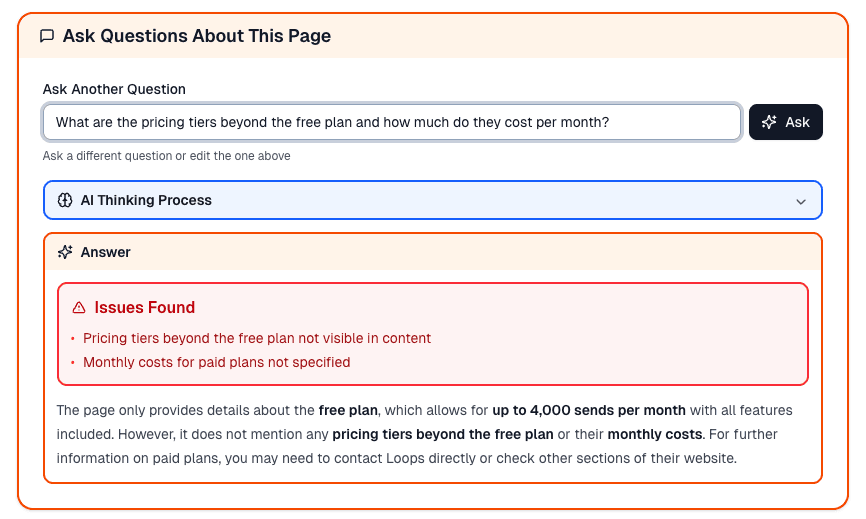
The result? When someone asks ChatGPT about Loops.so pricing, it can only see the free tier. So it keeps looking... and finds a competitor's blog post instead.
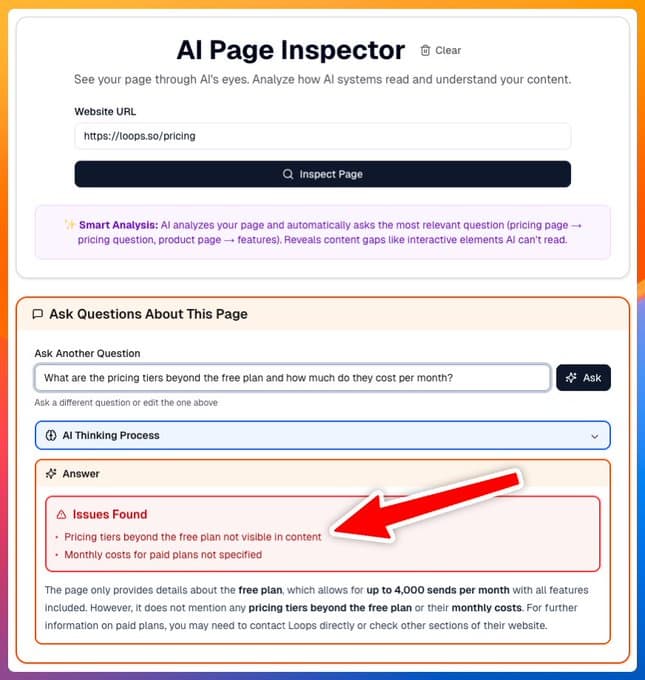
Here's what's happening:
- User asks ChatGPT about Loops.so pricing
- ChatGPT crawls Loops.so, only sees "Free plan"
- ChatGPT searches for more info, finds Encharge's blog
- Encharge's content is AI-readable markdown with full pricing details
- ChatGPT cites Encharge instead of the official source
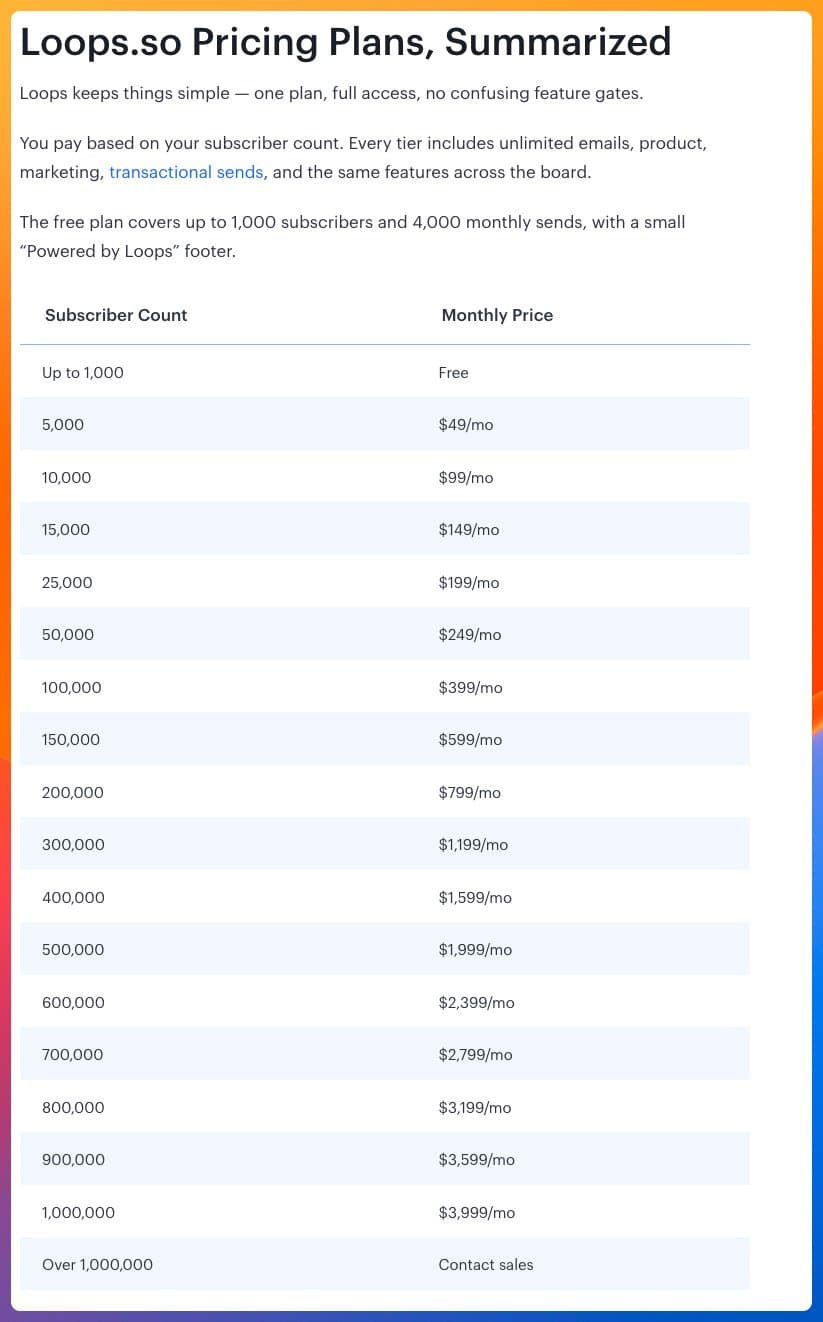
Your official pricing page exists. But AI can't read it. So it finds pricing info elsewhere—often from competitors who understand AI SEO.
The kicker? Encharge even includes a 3.8/5 score for Loops.so, effectively trash-talking competitors while ranking higher in AI search results.
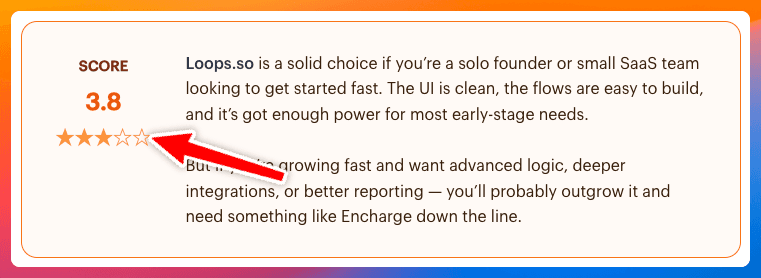
Features in Carousels
Second most common issue. Key features hidden in rotating carousels or tabbed interfaces.
AI only sees the first tab. Or worse, just the navigation buttons.
What you show: "5 powerful features that make us unique" What AI reads: Button labels with no context
Dynamic Product Information
Third major gap. Product details that load based on user selection.
Example: E-commerce sites with variant selectors. Click for different colors, sizes, configurations. Each click loads new details via JavaScript.
AI sees the default option only. Sometimes not even that.
The Encharge vs Loops.so Case Study
This isn't hypothetical. This is happening right now.
Loops.so is a great product. But Encharge is winning the AI SEO battle by creating comprehensive, AI-readable comparison content.
What Encharge Did Right
1. Created comprehensive comparison pages
- Deep dives into competitor products
- Screenshots, feature lists, pricing tables
- All in clean, markdown-friendly format
2. Made it AI-readable
- No JavaScript dependencies
- Static HTML with semantic structure
- Clear headings and lists
3. Added strategic commentary
- Pros and cons for each competitor
- Scores and ratings (even if subjective)
- Positioning themselves as the authority
Result: When ChatGPT needs info about Loops.so, it finds Encharge's content first.
What Loops.so Lost
- Official pricing invisible - Only free tier readable by AI
- Competitor controls the narrative - Encharge defines Loops.so's strengths and weaknesses
- Lost citations - Missing from AI search results for their own product category
- Traffic to competitors - Users end up at Encharge's site instead
The lesson: If your content isn't AI-readable, someone else will create AI-readable content about you. And they won't be flattering.
More Real Examples We Found
We analyzed 50+ SaaS sites. Here are the patterns:
Project Management Tools
Human sees: Interactive Gantt chart demos AI reads: Empty div containers Result: AI has no idea the product offers Gantt charts
Analytics Dashboards
Human sees: Live data visualization AI reads: "Loading..." placeholder text Result: AI thinks the product is broken
CRM Software
Human sees: Expandable feature comparison tables AI reads: Just the row headers, no details Result: AI cites competitors with simpler layouts
The pattern is clear. The more interactive your page, the less AI comprehends.
How to Find Your Content Gaps
Our AI Page Inspector tool shows you exactly what AI reads from your pages. This is the same tool we used to analyze Loops.so.
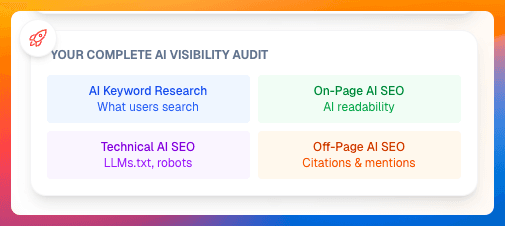
Step 1: Analyze Your Page
Paste your pricing page URL. The tool fetches it like ChatGPT would.
You get clean, markdown-formatted content. This is what LLMs actually process.
No CSS. No JavaScript. Just text structure.
Try it with your site: aiseotracker.com/page-inspector
Step 2: Compare Content
Look at what's missing. Check these critical elements:
- Pricing information (all tiers, not just one)
- Feature lists (complete, not just headers)
- Product specifications (details, not placeholders)
- Use cases (specific examples)
- Customer testimonials (actual quotes)
- Call-to-action details (clear next steps)
If it's not in the markdown output, AI can't see it.
Step 3: Ask AI Questions
The tool includes contextual Q&A. AI automatically generates and answers relevant questions about your page.
Pricing page? It asks about pricing tiers and costs. Product page? It asks about features and capabilities. Blog post? It asks about key insights and takeaways.
For Loops.so, AI asked: "What are the pricing tiers beyond the free plan?" AI's answer: "Pricing tiers beyond the free plan not visible in content" ❌
See what AI can actually extract from your content.
Step 4: Test Follow-Up Questions
Ask your own questions. "What are the pricing tiers?" "What features are included?" "How does this compare to X?"
If AI can't answer accurately, you have a content gap.
If AI can't find the info on your site, it will find it on a competitor's site. Just like it did with Loops.so and Encharge.
Before/After: Fixing AI-Invisible Content
Here's how to solve the most common issues.
Fix: Invisible Pricing
Before:
// Interactive slider, AI can't read
<PricingSlider onChange={updatePrice} />After:
// Keep the slider for humans
<PricingSlider onChange={updatePrice} />
// Add static content for AI
<LLMOnly>
<h2>Starter Plan - $29/month</h2>
<ul>
<li>5 users</li>
<li>10GB storage</li>
<li>Email support</li>
</ul>
<h2>Pro Plan - $99/month</h2>
<ul>
<li>25 users</li>
<li>100GB storage</li>
<li>Priority support</li>
</ul>
</LLMOnly>The <LLMOnly> component shows content exclusively to AI bots. Humans still see your beautiful slider. AI gets readable pricing data.
Learn more in our LLMOnly component guide.
Fix: Hidden Features
Before:
// Features in tabs, only first tab visible to AI
<Tabs>
<Tab name="Integration">Content here</Tab>
<Tab name="Analytics">Content here</Tab>
<Tab name="Security">Content here</Tab>
</Tabs>After:
// Keep tabs for humans
<Tabs>...</Tabs>
// Add flat list for AI
<LLMOnly>
<h2>Integrations</h2>
<p>Connect with Slack, Salesforce, HubSpot...</p>
<h2>Analytics</h2>
<p>Real-time dashboard, custom reports...</p>
<h2>Security</h2>
<p>SOC 2 compliant, SSO, 2FA...</p>
</LLMOnly>All features become AI-readable. Your interactive UI stays intact for users.
Fix: Dynamic Content
Before:
// Product details load on selection
<ProductVariantSelector onSelect={loadDetails} />After:
// Keep dynamic selector
<ProductVariantSelector onSelect={loadDetails} />
// Add comprehensive list for AI
<LLMOnly>
<h2>Available Options</h2>
<h3>Small (Blue, Red, Green)</h3>
<p>Dimensions: 10x10x10cm, Weight: 200g, Price: $29</p>
<h3>Medium (Blue, Red, Green)</h3>
<p>Dimensions: 20x20x20cm, Weight: 800g, Price: $49</p>
</LLMOnly>AI sees all variants. Users still get the interactive experience.
AI Page Inspector vs Traditional SEO Tools
Traditional SEO tools like Google Search Console focus on Google's crawler. That's fine for classic search.
But AI crawlers work differently.
Google Search Console
- Shows Google's indexing status
- Reports search performance
- Identifies technical SEO issues
- Tracks keyword rankings
Focus: How Google ranks your pages for traditional search
AI Page Inspector
- Shows clean, AI-readable content
- Identifies content gaps AI can't parse
- Tests AI's understanding with Q&A
- Reveals what AI actually extracts
Focus: How AI systems understand and cite your content
You need both. Google Search Console for traditional SEO. AI Page Inspector for AI search optimization.
They solve different problems. Google tells you how you rank. We show you what AI actually sees.
The Connection to AI Citations
Here's why this matters for your business.
When someone searches "best email marketing tools" in ChatGPT, it cites sources. Those citations drive traffic.
But AI only cites what it understands. If your content is invisible, you don't get cited.
The Loops.so example proves this pattern:
- Loops.so has great product with excellent UI
- Website looks beautiful with interactive pricing slider
- AI can't read the pricing information
- Encharge created AI-readable comparison content about Loops.so
- ChatGPT cites Encharge instead of Loops.so
- Loops.so loses potential customers to Encharge
- Worse: Encharge's content includes negative reviews (3.8/5 score)
This is the cost of invisible content. Not just lost citations—your competitors control your narrative.
The fix is simple. Make your content AI-readable.
Not by dumbing down your site. Not by removing interactive elements. Just by adding AI-visible structured content alongside your existing design.
Keep your beautiful pricing slider. Just add static pricing for AI bots to read. That's it.
Start Fixing Your Content Gaps
The AI search landscape is here. Encharge is winning. Your competitors are winning. Companies optimizing now are getting cited more often.
Those waiting? Losing citations to competitors every day. And those competitors might be writing less-than-flattering content about you.
Here's your action plan:
Today: Run your pricing page through AI Page Inspector. See what's invisible.
Input: https://yourdomain.com/pricing
Output: Exactly what ChatGPT, Perplexity, and Claude can read
This week: Add <LLMOnly> components to critical pages. Start with pricing—it's costing you the most.
This month: Test all major product pages. Fix the gaps. Monitor AI citation improvements.
Your content doesn't need to change. Your beautiful UI doesn't need to change. You just need to add AI-readable content alongside it.
Loops.so could fix their issue in 1 hour:
- Keep the pricing slider
- Add
<LLMOnly>wrapper with static pricing - AI sees all tiers
- ChatGPT stops citing Encharge
The tools exist. The fix is straightforward. The question is: will you fix it before your competitor writes about you?
Test Your Site for AI Visibility
See exactly what ChatGPT, Perplexity, and Claude read from your pages. Find content gaps in 30 seconds.
Try AI Page Inspector Free →No signup required. Results saved in your browser.


